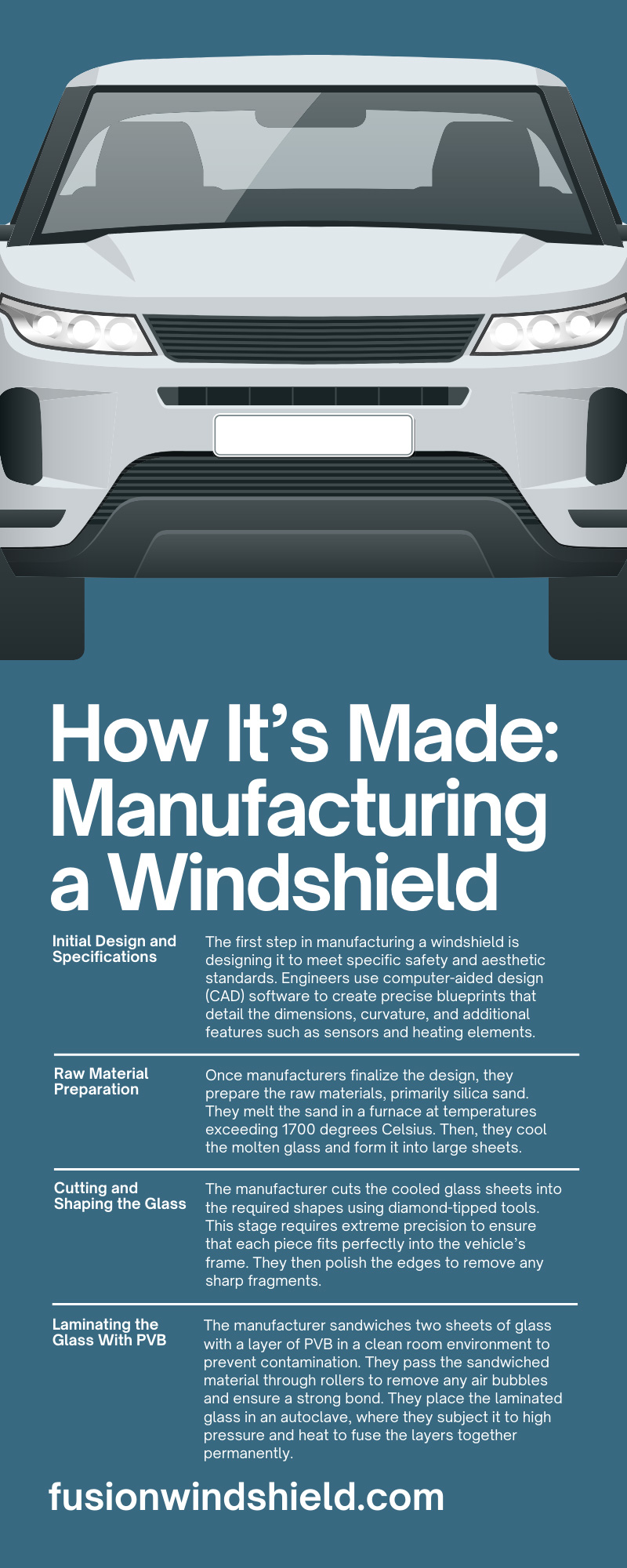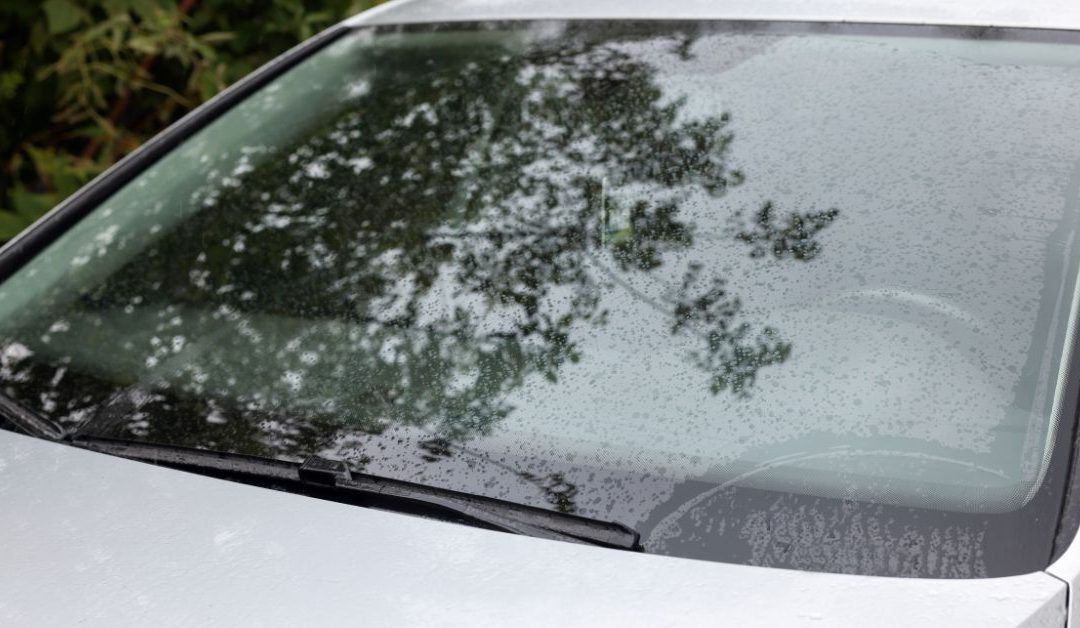Windshields do more than just keep the bugs and wind out of your face while you drive. They’re a critical safety feature, playing a pivotal role in maintaining a vehicle’s structural integrity. Understanding how a windshield is made, from manufacturing to distribution, is not only fascinating but essential for those in the automotive world. To this end, we’ll take a comprehensive tour of the process, highlighting the innovations, materials, and future trends of this automotive component.
Materials Used in Windshield Manufacturing
Glass and Polyvinyl Butyral (PVB)
Windshields primarily consist of two materials: glass and polyvinyl butyral (PVB). The glass used is a special type of laminated safety glass that comprises two layers with a PVB layer in between. The PVB layer is crucial as it holds the glass together during an impact, preventing shattering and reducing the risk of injury.
Silica Sand and Its Role
The primary ingredient in the glass is silica sand, which manufacturers melt down at extremely high temperatures to form the transparent, durable material we see. They also include other additives, such as soda ash and limestone, to improve the glass’s strength and clarity.
Additional Materials
In addition to glass and PVB, manufacturers use other materials such as coatings for UV protection, heating elements for defrosting, and various adhesives to enhance the windshield’s functionality and safety.
Step-by-Step Process of Creating a Windshield
Initial Design and Specifications
The first step in manufacturing a windshield is designing it to meet specific safety and aesthetic standards. Engineers use computer-aided design (CAD) software to create precise blueprints that detail the dimensions, curvature, and additional features such as sensors and heating elements.
Raw Material Preparation
Once manufacturers finalize the design, they prepare the raw materials, primarily silica sand. They melt the sand in a furnace at temperatures exceeding 1700 degrees Celsius. Then, they cool the molten glass and form it into large sheets.
Cutting and Shaping the Glass
The manufacturer cuts the cooled glass sheets into the required shapes using diamond-tipped tools. This stage requires extreme precision to ensure that each piece fits perfectly into the vehicle’s frame. They then polish the edges to remove any sharp fragments.
Laminating the Glass With PVB
The manufacturer sandwiches two sheets of glass with a layer of PVB in a clean room environment to prevent contamination. They pass the sandwiched material through rollers to remove any air bubbles and ensure a strong bond. They place the laminated glass in an autoclave, where they subject it to high pressure and heat to fuse the layers together permanently.
Adding Finishing Touches
The manufacturer adds additional features such as UV protection coatings, heating elements, and rain sensors during the final stages. They either integrate these add-ons into the PVB layer or apply them to the glass surface.
Quality Control and Testing
The windshield undergoes rigorous quality control tests before it’s ready for installation. Only after passing these stringent tests is a windshield deemed ready for the market. These are the key steps manufacturers must take:
- They subject the windshield to high-velocity impact tests using simulated projectiles. Each windshield must demonstrate its ability to withstand impact without shattering.
- They use specialized equipment to ensure the glass meets optical clarity standards. Then, they identify and reject any defects, such as distortions or impurities.
- They use precise measuring tools to gauge the thickness of both the glass and PVB layers. Consistency in thickness is crucial for structural integrity and safety.
- Windshields then undergo stress tests to measure their resilience under various conditions. Manufacturers must use techniques such as bending tests to assess the windshield’s overall strength.
- They test the bond between the glass layers and the PVB to ensure strong adhesion. Samples are subject to shear tests to verify the durability of the laminated layers.
- They expose the windshield to extreme temperature variations and humidity to test their durability. This test ensures that the windshield can withstand diverse weather conditions without compromising safety.
- Manufacturers test the UV protection coatings for effectiveness and durability. These coatings must demonstrate longevity and continued protection over time.
- They test windshields with integrated heating elements to confirm proper functionality. Electrical testing ensures that defrosting systems work efficiently without causing any damage to the glass.
- They conduct a final comprehensive visual and tactile inspection to detect any remaining defects. The windshield receives installation approval only after passing this meticulous final check.
- The manufacturer ships the finished windshields to automotive assembly lines, where they can install them into vehicles using specialized adhesives.
While this list isn’t comprehensive, it highlights the rigorous processes that go into windshield manufacturing to ensure consumer safety.
Installation Into Vehicles
The windshield installation process is meticulous. However, manufacturers carry out the process to ensure it fits perfectly and provides maximum safety. Initially, they carefully remove the old windshield using specialized tools to prevent any damage to the vehicle frame. They then thoroughly clean and prep the mounting surface, ensuring no debris or adhesive residue remains. They apply a high-quality adhesive around the mounting area’s perimeter.
They position the new windshield precisely, ensuring it aligns perfectly with the vehicle frame. Once in place, they apply pressure to ensure the adhesive creates a strong, uniform bond. They leave the vehicle undisturbed for a specified curing period, allowing the adhesive to set properly. Finally, they conduct a thorough inspection to confirm the windshield is secure, free of defects and meets all safety standards.
Technology and Innovation in Windshield Manufacturing
Advanced Materials
Innovation in materials science has led to the development of new types of laminated glass that offer better UV protection, higher impact resistance, and even self-healing properties. These advancements make windshields safer and more durable.
Smart Windshields
The integration of technology into windshields has given rise to “smart windshields” that can display information such as speed, navigation directions, and even advanced driver-assistance systems (ADAS) data directly onto the glass. These windshields use heads-up display (HUD) technology and augmented reality (AR) to perform these tasks.
Automated Manufacturing Processes
Automation is revolutionizing the windshield manufacturing process. Manufacturers are increasingly using robots for tasks such as cutting, shaping, and installing windshields, improving precision and efficiency while reducing production costs.
Environmental Considerations and Sustainability Practices
Recycling and Reuse
The automotive industry is becoming more environmentally conscious, and windshield manufacturing is no exception. They are making efforts to recycle old windshields and reuse materials in new production processes. For example, manufacturers can extract and repurpose PVB layers, reducing waste and conserving resources.
Energy-Efficient Production
Modern manufacturing plants are adopting energy-efficient technologies to minimize their carbon footprint. These adoptions include renewable energy sources, furnace temperature optimization, and waste heat recovery systems.
Eco-Friendly Materials
Research is underway to develop eco-friendly alternatives to traditional materials used in windshields. For instance, manufacturers are exploring biodegradable polymers as potential replacements for PVB, offering a more sustainable option without compromising safety.
Appreciating This Essential Automotive Component
Windshields are an integral part of the modern automobile, offering protection, enhancing structural integrity, and providing smart functionalities. By understanding windshield manufacturing and how windshields are made, we gain a deeper appreciation for this essential component.
Are you concerned about your windshield’s quality and durability? A mobile windshield calibration from Fusion Windshield Repair will ensure you’re driving safely and comfortably. See for yourself how we can improve the quality of your ride!



Recent Comments